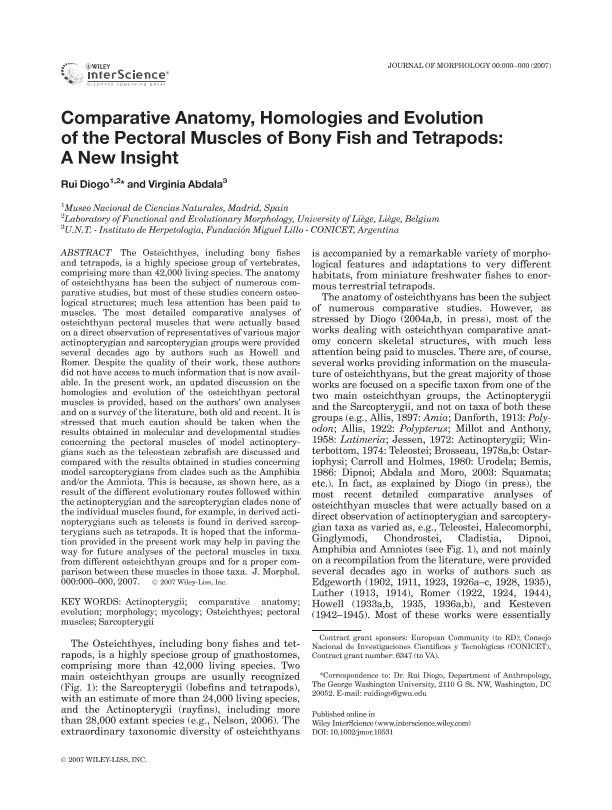Mostrar el registro sencillo del ítem
dc.contributor.author
Diogo, Rui
dc.contributor.author
Abdala, Virginia Sara Luz

dc.date.available
2019-09-04T17:31:16Z
dc.date.issued
2007-12
dc.identifier.citation
Diogo, Rui; Abdala, Virginia Sara Luz; The pectoral muscles of bony fishes and tetrapods: a new insight; Wiley-liss, Div John Wiley & Sons Inc; Journal of Morphology; 268; 6; 12-2007; 504-517
dc.identifier.issn
0362-2525
dc.identifier.uri
http://hdl.handle.net/11336/82886
dc.description.abstract
The Osteichthyes, including bony fishes and tetrapods, is a highly speciose group of vertebrates, comprising more than 42,000 living species. The anatomy of osteichthyans has been the subject of numerous comparative studies, but most of these studies concern osteological structures; much less attention has been paid to muscles. The most detailed comparative analyses of osteichthyan pectoral muscles that were actually based on a direct observation of representatives of various major actinopterygian and sarcopterygian groups were provided several decades ago by authors such as Howell and Romer. Despite the quality of their work, these authors did not have access to much information that is now available. In the present work, an updated discussion on the homologies and evolution of the osteichthyan pectoral muscles is provided, based on the authors´ own analyses and on a survey of the literature, both old and recent. It is stressed that much caution should be taken when the results obtained in molecular and developmental studies concerning the pectoral muscles of model actinopterygians such as the teleostean zebrafish are discussed and compared with the results obtained in studies concerning model sarcopterygians from clades such as the Amphibia and/or the Amniota. This is because, as shown here, as a result of the different evolutionary routes followed within the actinopterygian and the sarcopterygian clades none of the individual muscles found, for example, in derived actinopterygians such as teleosts is found in derived sarcopterygians such as tetrapods. It is hoped that the information provided in the present work may help in paving the way for future analyses of the pectoral muscles in taxa from different osteichthyan groups and for a proper comparison between these muscles in those taxa
dc.format
application/pdf
dc.language.iso
eng
dc.publisher
Wiley-liss, Div John Wiley & Sons Inc

dc.rights
info:eu-repo/semantics/openAccess
dc.rights.uri
https://creativecommons.org/licenses/by-nc-sa/2.5/ar/
dc.subject
Osteichthyes
dc.subject
Anatomy of Osteichthyans
dc.subject
Evolutionary Routes
dc.subject.classification
Zoología, Ornitología, Entomología, Etología

dc.subject.classification
Ciencias Biológicas

dc.subject.classification
CIENCIAS NATURALES Y EXACTAS

dc.title
The pectoral muscles of bony fishes and tetrapods: a new insight
dc.type
info:eu-repo/semantics/article
dc.type
info:ar-repo/semantics/artículo
dc.type
info:eu-repo/semantics/publishedVersion
dc.date.updated
2019-08-29T15:41:43Z
dc.journal.volume
268
dc.journal.number
6
dc.journal.pagination
504-517
dc.journal.pais
Estados Unidos

dc.journal.ciudad
Nueva York
dc.description.fil
Fil: Diogo, Rui. Museo Nacional de Ciencias Naturales; España. University of Liège; Bélgica. The George Washington University; Estados Unidos
dc.description.fil
Fil: Abdala, Virginia Sara Luz. Consejo Nacional de Investigaciones Científicas y Técnicas. Centro Científico Tecnológico Conicet - Tucumán. Instituto de Biodiversidad Neotropical. Universidad Nacional de Tucumán. Facultad de Ciencias Naturales e Instituto Miguel Lillo. Instituto de Biodiversidad Neotropical. Instituto de Biodiversidad Neotropical; Argentina
dc.journal.title
Journal of Morphology

dc.relation.alternativeid
info:eu-repo/semantics/altIdentifier/doi/https://doi.org/10.1002/jmor.10531
dc.relation.alternativeid
info:eu-repo/semantics/altIdentifier/url/https://onlinelibrary.wiley.com/doi/epdf/10.1002/jmor.10531
Archivos asociados
